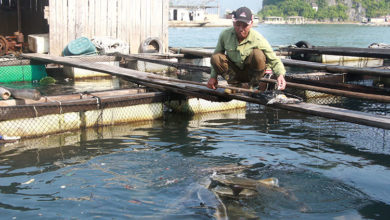The series on Sustainable Marine Aquaculture: Article 1 – Reducing cage density
The lobster farming industry in Vietnam's Central South region is facing significant challenges that must be addressed for sustainable development.
High cage density
With its long coastline and numerous lagoons and bays, Phu Yen and Khanh Hoa provinces have developed cage farming since the 1990s, focusing on lobsters and various marine fish. Today, lobster cage farming has become a key industry in these regions.
Song Cau town (Phu Yen) has significant potential for marine aquaculture, with Cu Mong Lagoon covering 2,600 hectares, Xuan Dai Bay spanning 8,000 hectares, and over 1,300 hectares of offshore waters. According to the People’s Committee of Song Cau Town, 4,196 households are engaged in aquaculture, operating 6,390 rafts—3,376 for oysters and 3,014 for lobsters. The town also hosts 134,612 sea fish cages and 129,321 cages for farming commercial lobsters.

According to Lam Duy Dung, Vice Chairman of Song Cau town’s People’s Committee, lobster farming in the area faces challenges, including reliance on imported seed. This makes it difficult to control seed quantity, quality, and breeding seasons. Local farmers mostly use traditional methods with wooden cages, outdated technology, and rely solely on fresh feed. The farming density is high, and practices do not comply with regulations, creating significant risks from environmental factors, natural disasters, and diseases.
Pham Van Phai, a lobster farmer in Xuan Thanh Ward (Song Cau town), has noticed a growing environmental pollution issue in aquaculture areas in recent years. He attributes this to the high density of fish cages and some farmers’ failure to follow environmental regulations, particularly regarding proper feed collection and disposal.
Doan Van Quang, Director of the Song Cau Lobster Service Cooperative, said lobster farming is becoming more challenging. Mortality rates are high from stocking to harvesting, with some households facing production losses of up to 50%. In addition to the impacts of climate change and weather, the high density of cage farming results in poor water circulation, negatively affecting the health of the lobsters.
According to the Phu Yen Department of Agriculture and Rural Development, the province will have over 186,000 seafood farming cages by June 2024, 3.8 times the planned number. Deputy Director Nguyen Tri Phuong warned that this high cage density poses a significant environmental risk. Additionally, lobster farms suffer annual losses of 20-30% due to diseases like white spot and black gill.
In May and June 2024, two incidents of sudden mass mortality of farmed lobsters and marine fish occurred in Song Cau, resulting in a loss of 45.7 billion VND. Authorities identified overcrowding in farming cages and the use of shellfish as lobster feed, which obstructed water circulation, as the causes.
Environmental risks
Khanh Hoa Province has four marine cage farming areas: Vạn Ninh, Ninh Hoa, Nha Trang, and Cam Ranh. Among them, Van Phong Bay (Van Ninh) and Cam Ranh Bay (Cam Ranh City) are the main hubs for lobster and marine fish farming, with a high concentration of cages near the shore.
According to the head of Van Ninh District’s Economic Department, the district currently has around 42,000 fish farming cages, mostly concentrated in Van Thanh Commune, with approximately 50% used for lobster farming. Many households are still farming outside the designated areas.
Nguyen Xuan Hoa, an experienced lobster farmer from Van Gia town (Van Ninh district), shared that many people from other regions are now coming to Van Phong Bay for aquaculture. This has increased the density of fish cages, reducing water quality. Additionally, many farmers have failed to properly dispose of household waste and excess food onshore. As a result, lobster farming profitability has decreased due to rising environmental risks, disease threats, and lack of market integration.
Le Ngoc Thach, Chairman of the People’s Committee of Cam Ranh City, stated that nearly 100,000 aquaculture cages are currently in use in Cam Ranh Bay, mainly for farming green lobsters. With such high cage density, the risk of environmental damage is imminent. Thach expressed concern, stating that farming is still possible, but the risk of significant damage due to overstocking is high.
According to Nguyen Duy Quang, Director of the Department of Agriculture and Rural Development of Khanh Haa, local residents have recently been engaging in unregulated lobster farming near the shore, outside approved areas. This has led to environmental pollution, increased disease risks, and conflicts over water surface usage with other sectors, reducing farming efficiency and harming scenic beauty.
In some areas, lobster farming has encroached on maritime safety zones and anchorage areas, blocking vessel movement and disrupting waterway traffic.
VFM






